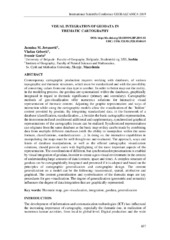| dc.description.abstract | Contemporary cartographic production requires working with databases, of various topographic and thematic structures, which must be standardized and with the possibility of converting values from one data type to another. In order to better map out the reality, in the modeling process, the geodata are systematized within the databases, graphically integrated in regard to thematic significance (primary and secondary). Cartographic methods of geo-visualization offer numerous solutions for interactive visual representation of thematic content. Adjusting the graphic representation and ways of interaction while using the cartographic models allow the visualization of the "hidden" content provided by geodata. By integrating standardized data, in the framework of a database (classification, standardization ...), besides the basic cartographic representation, the interconnected and conditioned additional and supplementary, synchronized graphical representations of the cartographic issues can be realized. Synchronized representations can originate from the same database as the basic map or they can be made by combining data from multiple different databases (with the ability to manipulate within the same formats, classifications, standardizations ...). In doing so, the interactive capabilities in manipulating the maps must be well thought out and evaluated. The approach, ways and limits of database manipulation, as well as the offered cartographic visualization solutions, should provide users with highlighting of the most important aspects of the representation. The coordination of different, but synchronized representations is enabled by visual integration of geodata, in order to create a geo-visual environment in the context of understanding large amounts of data (content, space and time). A complex structure of geodata can be cartographically integrated and presented if it is adapted and based on the principles of cartographic generalization and cartographic design. The content generalization on a model can be the following: taxonomical, spatial, attributive and graphical. The content generalization and symbolization of the thematic maps are key procedures for geo-visualization. The degree of generalization (geometric and semantic) influences the degree of data integration that are graphically represented. | sr |


